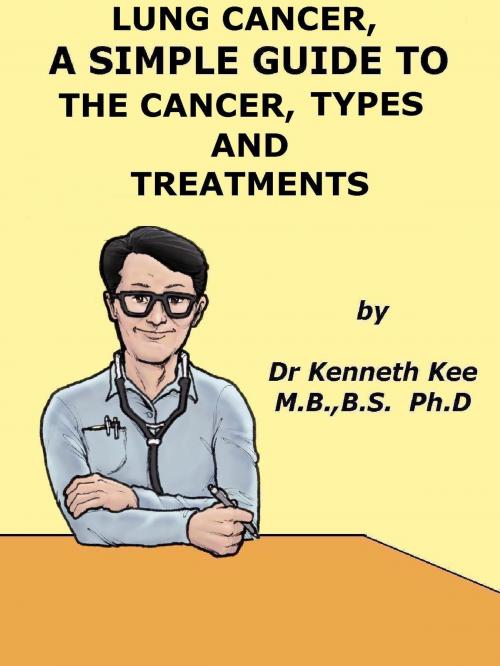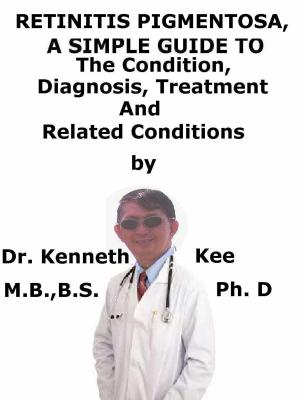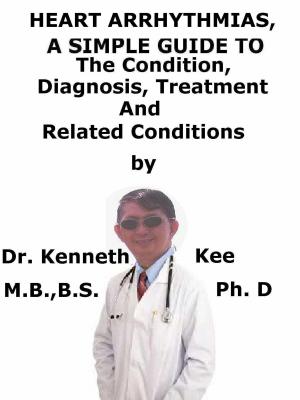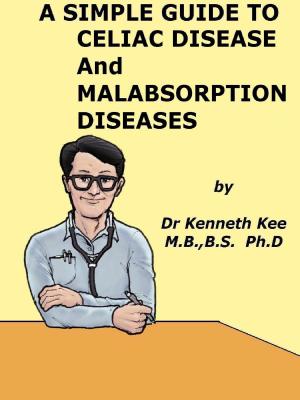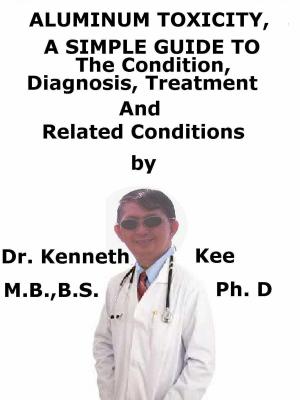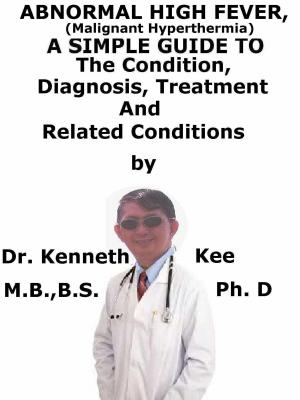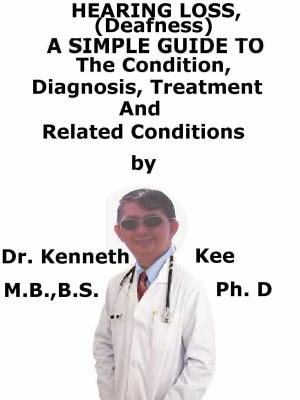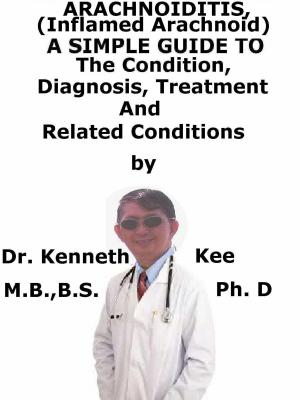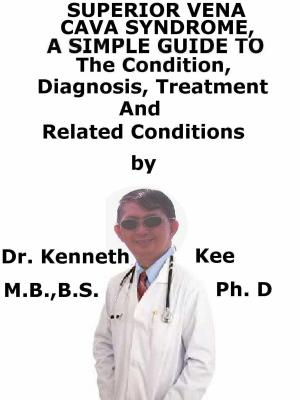Lung Cancer, A Simple Guide To The Cancer, Types And Treatments
Nonfiction, Health & Well Being, Medical, Specialties, Oncology, Health, Ailments & Diseases, Cancer| Author: | Kenneth Kee | ISBN: | 9781370058167 |
| Publisher: | Kenneth Kee | Publication: | September 30, 2016 |
| Imprint: | Smashwords Edition | Language: | English |
| Author: | Kenneth Kee |
| ISBN: | 9781370058167 |
| Publisher: | Kenneth Kee |
| Publication: | September 30, 2016 |
| Imprint: | Smashwords Edition |
| Language: | English |
Lung cancer is the most common cancer in Singapore men.
Smoking (active and passive) contributes to this cancer as does inhalation of asbestos and other toxic chemicals.
While the incidence of men smoking has decreased there are alarmingly more women who are smoking.
A lung cancer patient of mine recounts his regret in long term smoking which led to his condition with the breathlessness, loss of weight, heart failure and weakness.
He eventually succumbed to his illness.
Just 2 weeks ago a middle aged woman professional of 65 years had her usual annual medical examination.
To her horror her chest X-ray showed evidence of cancer of the lung.
CT scan of the lungs and liver showed the presence of Stage 4 cancer of the lung which had spread to the liver.
She was given 6 months to live.
She was not even a smoker.
Lung Cancer is the uncontrolled growth of abnormal cells in one or both lungs.
The cells lining air passages grow and divide until an abnormal mass or tumor is formed.
There are 2 main types of Lung Cancer:
1. Small cell lung cancer (SCLC)
Small cell lung cancer (SCLC) has the most aggressive clinical course of any type of pulmonary tumor, with median survival from diagnosis of only 2 to 4 months.
2. Non-small cell lung cancer
a. Squamous cell carcinoma:
Cancer that begins in squamous cells, which are thin, flat cells that look like fish scales, also called epidermoid carcinoma.
b. Large cell carcinoma:
Cancer that may begin in several types of large cells.
c. Adenocarcinoma:
Cancer that begins in the cells that line the alveoli.
d. Other less common types of non-small cell lung cancer are:
pleomorphic, carcinoid tumor, salivary gland carcinoma, and unclassified carcinoma.
These types are based on how the cells look under a microscope.
The Non-small cell Lung cancer often seen in middle aged and elderly persons may take up to 10-30 years to develop.
Once developed Lung cancers tend to spread quickly because the lungs are richly supplied by blood and lymph vessels.
In the travel through the lymph vessels, it can cause enlarged lymph nodes.
If it enters the blood, the cancer cells can spread to the liver, bone, brain or other parts of the body.
Causes are:
1. Cigarette smoking is the main cause
2. Cigar and pipe smoking
3. Passive smoking in a family where one member smokes
4. Industrial hazards such as chemicals and smoke emitted at workplace, such as asbestos, coal gas, chromates, uranium.
5. Radiation therapy to the breast or chest.
Chest X-ray and MRI of lung can detect Lung Cancer.
The treatment of cancer consists of Surgery, Radiotherapy and chemotherapy. The choice of treatment depends on the size, extent and the type lung cancer and the general health of the patient. Small cell lung cancer is mostly treated with chemotherapy.
Non small cell lung cancer can be treated with surgery, chemotherapy, radiotherapy or a combination of these.
No one wants cancer or his body cell to becomes mutant
But when the body mutates and become malignant
There is nothing much that you can do about it
All you do is hope the cancer cells can be removed by surgery
The other treatments in the past is radiation or chemotherapy
Now there are stem cells, hormone treatment and immunotherapy
Targeted therapy is focused directly on a particular cluster of cancer cells
The exact location where the cancer cells dwell
Avoid smoking if possible; cigarette smoke has 40 types of carcinogens
Avoid alcohol which can cause cancer of mouth, eosphagus and liver conditions
Avoid chemicals like asbestos, alphatoxins from nuts and silica
Avoid sun rays, radiation from phones, viral infections and trauma
-An original poem by Kenneth Kee
TABLE OF CONTENT
Introduction
Chapter 1 Lung Cancer
Chapter 2 More Facts of Lung Cancer
Chapter 3 Treatment of Lung Cancer
Chapter 4 SCLC Cancer
Chapter 5 Treatment of SCLC Cancer
Chapter 6 NSCLC Cancer
Chapter 7 Treatment of NSCLC Cancer
Chapter 8 Mesothelioma
Epilogue
Lung cancer is the most common cancer in Singapore men.
Smoking (active and passive) contributes to this cancer as does inhalation of asbestos and other toxic chemicals.
While the incidence of men smoking has decreased there are alarmingly more women who are smoking.
A lung cancer patient of mine recounts his regret in long term smoking which led to his condition with the breathlessness, loss of weight, heart failure and weakness.
He eventually succumbed to his illness.
Just 2 weeks ago a middle aged woman professional of 65 years had her usual annual medical examination.
To her horror her chest X-ray showed evidence of cancer of the lung.
CT scan of the lungs and liver showed the presence of Stage 4 cancer of the lung which had spread to the liver.
She was given 6 months to live.
She was not even a smoker.
Lung Cancer is the uncontrolled growth of abnormal cells in one or both lungs.
The cells lining air passages grow and divide until an abnormal mass or tumor is formed.
There are 2 main types of Lung Cancer:
1. Small cell lung cancer (SCLC)
Small cell lung cancer (SCLC) has the most aggressive clinical course of any type of pulmonary tumor, with median survival from diagnosis of only 2 to 4 months.
2. Non-small cell lung cancer
a. Squamous cell carcinoma:
Cancer that begins in squamous cells, which are thin, flat cells that look like fish scales, also called epidermoid carcinoma.
b. Large cell carcinoma:
Cancer that may begin in several types of large cells.
c. Adenocarcinoma:
Cancer that begins in the cells that line the alveoli.
d. Other less common types of non-small cell lung cancer are:
pleomorphic, carcinoid tumor, salivary gland carcinoma, and unclassified carcinoma.
These types are based on how the cells look under a microscope.
The Non-small cell Lung cancer often seen in middle aged and elderly persons may take up to 10-30 years to develop.
Once developed Lung cancers tend to spread quickly because the lungs are richly supplied by blood and lymph vessels.
In the travel through the lymph vessels, it can cause enlarged lymph nodes.
If it enters the blood, the cancer cells can spread to the liver, bone, brain or other parts of the body.
Causes are:
1. Cigarette smoking is the main cause
2. Cigar and pipe smoking
3. Passive smoking in a family where one member smokes
4. Industrial hazards such as chemicals and smoke emitted at workplace, such as asbestos, coal gas, chromates, uranium.
5. Radiation therapy to the breast or chest.
Chest X-ray and MRI of lung can detect Lung Cancer.
The treatment of cancer consists of Surgery, Radiotherapy and chemotherapy. The choice of treatment depends on the size, extent and the type lung cancer and the general health of the patient. Small cell lung cancer is mostly treated with chemotherapy.
Non small cell lung cancer can be treated with surgery, chemotherapy, radiotherapy or a combination of these.
No one wants cancer or his body cell to becomes mutant
But when the body mutates and become malignant
There is nothing much that you can do about it
All you do is hope the cancer cells can be removed by surgery
The other treatments in the past is radiation or chemotherapy
Now there are stem cells, hormone treatment and immunotherapy
Targeted therapy is focused directly on a particular cluster of cancer cells
The exact location where the cancer cells dwell
Avoid smoking if possible; cigarette smoke has 40 types of carcinogens
Avoid alcohol which can cause cancer of mouth, eosphagus and liver conditions
Avoid chemicals like asbestos, alphatoxins from nuts and silica
Avoid sun rays, radiation from phones, viral infections and trauma
-An original poem by Kenneth Kee
TABLE OF CONTENT
Introduction
Chapter 1 Lung Cancer
Chapter 2 More Facts of Lung Cancer
Chapter 3 Treatment of Lung Cancer
Chapter 4 SCLC Cancer
Chapter 5 Treatment of SCLC Cancer
Chapter 6 NSCLC Cancer
Chapter 7 Treatment of NSCLC Cancer
Chapter 8 Mesothelioma
Epilogue
